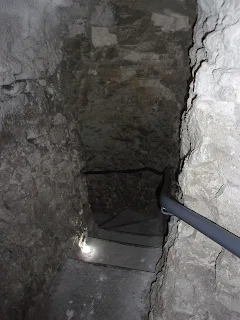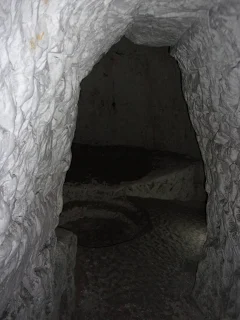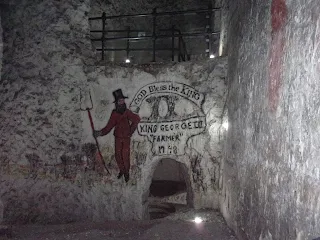Roll up, roll up! I give you the fascinating, subterranean Margate Caves, which once served as the ultimate "man cave..."
Also known as the Vortigern Caves, (Vortigern was a 5th century British King who is believed to have given Thanet as a bridal gift to his future son-in-law, Hengist), it was my first visit to see this eccentric underground delight, which was thought to have been discovered in 1798- although accounts regarding this date differ.
Closed since 2004, the visitor centre above ground was remodelled and the caves reopened in 2019. I was really looking forward to this and this cavernous space certainly didn't disappoint. It was the first touristy thing we did as part of my birthday trip to Margate, and you can read all about the rest of my Thanet adventures- which include Broadstairs and Ramsgate- in this blog:-
You enter the caves through a room dedicated to their history and layout. This is part of the brand new visitor centre; with an inquisitive SuperDean in the corner.
The caves were originally hand dug as a chalk quarry in the 17th and 18th centuries and form spectacular galleries. Chalk was mined for agricultural use, and to burn for lime, in this area since 1700, due to the development of the town. Here are the modern stairs down into the depths of intrigue...
Moving down through chalk, and once a mine had been mined it was sealed over. The reason could only be that no further chalk was required; and during the 18th century, as Margate expanded, a building was built on the site. It was occupied by Margaret Bryan, who was a bit of a revolutionary for her time...
...She strongly believed in the education of women, ran a boarding school for young ladies from the house and introduced her pupils to the wonders of scientific enquiry, natural philosophy and astronomy; firmly considered to be the domains of men. She never knew about the existence of the caves- a learned woman, I'm sure she would have been fascinated by them if she had.
I'm not sure if these blotches on the wall during our descent are a natural occurrence, or if they're simply splodges of paint.
Francis Forster was the heir to a substantial estate in Northumberland, and he bought the house at auction in 1807. He made alterations and changed the name to Northumberland House.
This is where dates differ, as it is during Forster's tenure that the caves were discovered. Again, accounts vary- it's been suggested that a gardener chanced upon a hole that led to the caves when his spade went right through the ground. Another story has the gardener actually falling and disappearing down the hole. Yet another has him dying from his injuries. Another tale has Forster himself discovering a hole at the base of a pear tree and investigating, revealing the caves. He was keen to solve the mystery of why rabbits kept disappearing down the hole...
...That story made its way into newspapers in 1863- the same year that Lewis Carroll wrote a story about another disappearing rabbit, which became Alice's Adventures in Wonderland (commonly known as Alice in Wonderland).
A sign of the times, and hand sanitiser sits in this little alcove...Forster decorated the caves and used them extensively as a wine cellar, ice well and grotto. He employed a local artist named Brazier to create some carvings and paint figures and scenes onto the walls. Paintings have been titivated and added since then.
Here are several views of the Thanet Hunt...
Hunting with dogs is now illegal, but it would have been popular in the 1800s. It's difficult to count the hounds as they chase after the fox in one solid lump, en-masse!
The little fox being chased by the hunters. It's thought that the hunt scene may have been chasing a hare, originally.
We took the lower level walkway which veered off to the left. It contains two ovoid pits, so called because they sit in egg-shaped sections, and are interconnected by a tunnel...
Various theories have been put forward as to the mysterious pits original use, ranging from actual dungeons, oubliettes or prisons to malt kilns.
A deeper section, and this place was certainly full of unexpected, weird delights. Dungeons would have been impossible to escape as the only exit was via the surface. But the bottom of each pit has a sloping floor and shallow shaft. This points to other, more practical uses.

Margate was once an important malting town, but the lack of fire pits or stokeholes puts paid to this theory
It has been suggested that maybe Forster also had a local artist embellish the caves with carvings/ etchings etc, to enhance the caves' reputation. It is possible that he had the pits dug at the same time for his own amusement? Could the ovoid pits have had a practical use as the storage of food or ice? Or were they simply somewhere to sit- a 19th century variation of a chill-out room?
Could the pits have been excavated later on, by owners hoping to enhance visitor interest (and thereby revenue) by spreading rumours of torture or dungeons? Years of etchings/ graffiti/ carvings (interpret as you will, and this place is certainly open to interpretation) adorned this and every section...
Some is readable and specific, although nowadays the volunteers do ask people to refrain from scratching their names!
The most plausible theory of the pits existence seems to be their usage as ice wells, as they have a "sump" at the base for excess water.
This area has suffered from minor, sporadic rock falls over the years, and this pit looks like it's been utilised as a wishing well.
This is the hole the gardener was alleged to have fallen through. That is one hell of a long drop...

There are other shafts in the roof, which once opened to the surface. Shallow grooves at the base of the shaft are from where the rope cut into the walls as it swung, laden down with chalk being hauled to the surface.
The Virgin Mary in a recess, just past the monkeys...
Some form of transport, usually a wheelbarrow would have been used to help transport the chalk, indicated by the long lengths of the corridors. Barrows were not generally used in the excavation of vertically accessed Kent chalk
mines until after the 14th century, putting paid to claims that the caves existed in Saxon times (considered to be 410-1066AD).
Three deer form part of this "underground zoo..."Francis Forster never opened the caves to the public, instead using it as an entertaining space and showing off his substantial wealth to his friends.

Closer, and she's ensconced within her personal little altar...
Looking out from the Virgin Mary, and you can just about make out the donkey on the wall to the right. Francis Forster used to tell a joke about a donkey in a box, but the original painting is long gone. This donkey is a nod to that jest...

Elephant, and there is a pub called The Mechanical Elephant in Margate. Margate has a long association with elephants- apparently they were a regular sight in the Margate of yesteryear, performing as a form of entertainment.
This central area has been used to stack up rubble from previous rock falls.

This artist has marked 1798 next to the painting- but was it painted then or after?

You can see a utility pipe above Farmer George. It's believed to be a sewage pipe.

On this hot, clammy day, the caves were lovely and cool. You take the stairs up to this elevated gallery, which has odd openings like this oblong...
Two works of a tiger and a Chinese prisoner in chains haven't survived. Their existence is mentioned in an account from 1863, when the caves opened to the public for the first time.
Walking up the highest set of stairs, and here are the remains of the entrance built by Forster, to access his cave. It must have had a set of stairs running downwards, until the later, main entrance was put into use.
Looking back down along this wondrous cavern, and the caves have been given a new lease of life due to public support and the formation of a fundraising group. The Friends of Margate Caves secured National Lottery funding in 2017, following a six-year campaign.

A dancing bear, and is there a ghost painting next to him? Some believe it's a mastiff dog baiting the bear, whilst others think it's the donkey in a box from Forster's aforementioned joke.
There is a well right here, and it's 13.7m deep. Rumours about smugglers using the tunnel to stash contraband started after the discovery of a shaft a short way up the well, but there is no evidence to support this. The opening did, in fact, lead onto an old cess pit.

After rubble was excavated- the result of World War II bombing- coins dating from the 1880s were found down here, indicating that it was used as a wishing well back in Victorian/ Edwardian times.
The paintings were more delicate in style (evident if you look closely) before being retouched in the 1900s.
The caves are 94.2m long and 12.2m tall at their highest point and after Forster's death, in 1835, were ignored until 1954. John Norwood bought the house and was a natural salesman, charging threepence admission and employing his talents to intrigue visitors. It was he who gave them the fanciful "Vortigern Caves" moniker (again, accounts differ- he may have called the caves "Vortigern Cavern") claiming that they dated from 454AD!
Old guide books describe a fossil ammonite which used to sit here, to the left, but it's now lost (possibly stolen by a visitor many years ago?)
The lion used to have Chinese guardian lion styling to his face before he was over-painted.
During the First and Second World Wars the caves were utilised as air-raid shelters. Northumberland House was severely damaged by enemy action in 1941, as was Holy Trinity Church in 1943. Both were demolished in 1958 and the entrance stairs to the caves were bricked up.
A quirky hippo- but why is he green? Is he some other form of pachyderm?
There is a crocodile here too, but silly me didn't get a piccie of him (I could kick myself!) Oh well, that's my excuse to return sorted.
In 1958 the proprietor of Chiselhurst Caves (I've now earmarked them as somewhere to visit😀) James Geary Gardner, became interested in opening the attraction. A new entrance was determined, after lifting a paving slab in the old vicarage gardens, which exposed the old brick vent above the main shaft. A modern set of stairs was created and the caves once again opened.
This ultraviolet giant was inspired by Richard Joy- the Thanet Giant- who was a smuggler. He's said to have been over seven foot tall and in possession of Herculean strength. The painting was created by Margate Art School, for Gardner, when the caves reopened.
Vortigern, painted in the 1980s by Karol Edward Osten-Sacken (quite a mouthful- he's more commonly known as KEOS). The face is believed to be a self-portrait, and is almost certainly crafted using used emulsion.
In the couple of years since their 2019 rebirth the caves have played host to everything from art exhibitions; scout meetings; local community learning groups about subjects such as book binding, graffiti, light and geology; to silent discos (where everyone listens to the music through headphones). In early 2021 it played host as the reception venue for a gothic couple's wedding. The caves offered a stunning backdrop to their photographs.
Of course, the caves aren't the only subterranean treat to feast your eyes upon in Margate- the Shell Grotto is nearby, and nobody knows its origins. Read about our recent visit here:-
Until then...
TTFN
The Miss Elaineous
XXXXXXXXXXXXXXXXXXXXXXXX
XXX
X








































No comments:
Post a Comment